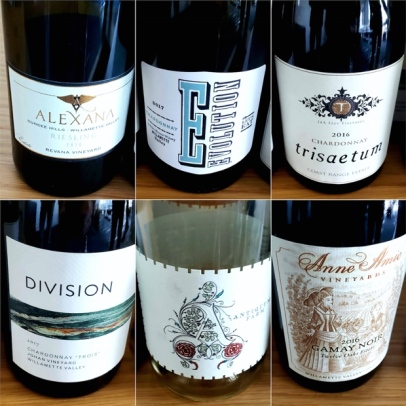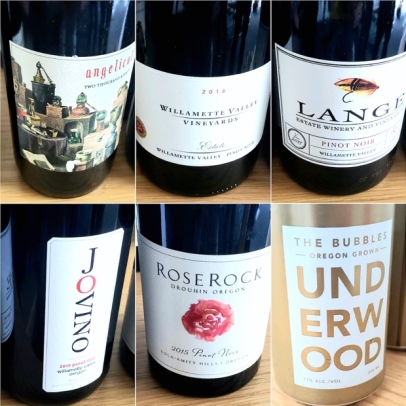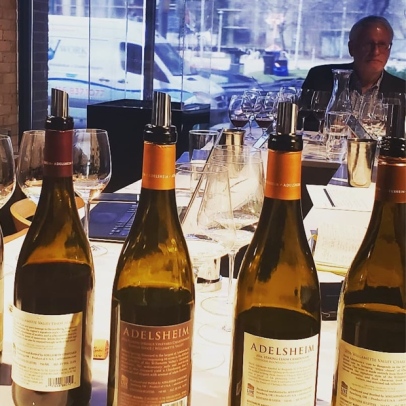Special Report: Emerging Oregon
Getting deeper into Oregon, thanks to a recent masterclass and trade tasting, as well as a private sit-down interview with the thoughtful David Adelsheim of Adelsheim Vineyard
by Michael Godel

Michael Godel
When I think of Oregon, it delivers me to a place where you saddle up to a pioneer town bar and lie beneath a blanket of stars. When I consider Oregon as a grape growing state I think of chardonnay and pinot noir vines cutting natural swaths through territory girded by mountains, an ocean and wide open skies. This latter notion does not stray far from the truth. The modern-day viticultural vernacular may only do its talking out of roots laid down for a mere 60 years but it is spoken with an unmatched sustainable clarity. Today Oregon’s wine presence is trenchant and persistent. If this is the golden era for Oregon wine, you’d better run to get your piece.
While the growing, fermenting and bottling of chardonnay has seen a recent transformation out of an emulation of a “style” to a new emergence that celebrates place over all else, according to David Adelsheim, in pinot noir “there’s probably more variation in winemaking in Burgundy today than in the Willamette Valley.” After our recent sit-down with the winemaker, John Szabo M.S. commented by saying, “That’s a big statement, intending to highlight the maturing industry’s cohesive focus on terroir rather than technique. Has Oregon got it all figured out?”
The Oregon Wine Board brought their travelling road show to Toronto’s Globe and Mail Centre on April 9, 2019. “Mastering Oregon” was led by two Masters, Bree Boskov M.W., OWB Education Manager and Christopher Tanghe M.S., Chief Instructor Guild of Sommeliers. Between Boskov and Tanghe no soil remained unturned, not volcanic, sedimentary nor windswept loess. The two masters covered Oregon’s history, timeline and 19 wine-growing regions. History, geology, topography and climate were discussed, first from the state’s northwest and nine most known appellations in and around the Willamette Valley, to four in the northern Columbia Gorge and Walla Walla Valley, five in Southern Oregon between the Siskiyou Mountains and Cascade Range and Snake River by the Idaho border.
Flights of whites and reds were poured at the Mastering Oregon seminar, including one riesling, three chardonnay, one pinot gris, one gamay, five pinot noir and finally, one sparkling wine in a can. Please click on the links to read my full tasting notes on the 12 wines tasted.
Oregon Masterclass Wines:
Alexana Winery Estate Riesling Revana Vineyard 2016, AVA Dundee Hills
Sokol Blossor Chardonnay Evolution 2017, AVA Willamette Valley
Trisaetum Estate Chardonnay Coast Range 2016, AVA Yamhill-Carlton
Division Winemaking Co. Chardonnay Trois 2016, AVA Willamette Valley (Van Duzer Corridor)
Antiquum Farm Pinot Gris Aurosa 2017, AVA Willamette Valley
Anne Amie Vineyards Gamay Noir 2016, AVA Chehelam Mountains
Antica Terra Pinot Noir Rosé Angelicall 2017, AVA Willamette Valley
Dobbes Family Estate Pinot Noir Jovino 2015, AVA Oregon
Willamette Valley Vineyards Estate Pinot Noir 2016, AVA Willamette Valley
Lange Estate Winery and Vineyards Reserve Pinot Noir 2015, AVA Willamette Valley
Domaine Drouhin Pinot Noir Roserock 2015, AVA Eola-Amity Hills
Union Wine Co., Underwood The Bubbles (Chardonnay & Pinot Noir) NV, AVA Oregon
After the seminar 30 wineries from the Willamette Valley, Rogue Valley, and Columbia Gorge AVA’s, plus the Urban Wineries Association of Portland got to pouring over 170 wines. The participating wineries were Foley Family Wines / Acrobat / The Four Graces / Jackson Family Wines / La Crema / Willakenzie / Siduri / Penner-Ash / Zena Crowne / A to Z Wineworks / Adelsheim Vineyard / Airlie Winery / Anne Amie Vineyards / Antiquum Farm / Archery Summit Winery / Argyle / Boedecker Cellars / Citation / Cristom Vineyards / Del Rio Vineyards / Division Winemaking Company / Domaine Drouhin / Elk Cove Vineyards / Foris Vineyards / Hyland Estates / Lange Estate Winery / Lavinea / Phelps Creek Vineyards / Portlandia Vintners / Sokol Blosser / Solena Estate / Stoller Wine Group / Trisaetum / Union Wine Company / Walter Scott / Westmount / Willakenzie / Wines by Joe/Jovino/ Antica Terra.
For more information on Oregon wines and the Oregon Wine Board please visit trade.oregonwine.org and to take it deeper, be sure to make use of Oregon’s newest educational tool, located at oregonwineresourcestudio.org. Here you can explore the Oregon wine story from all angles; climate and geology, history and environmental stewardship. Learn what makes each AVA distinct with statistics, maps and photography.
A visit and tasting with David Adelsheim and Mark Anthony Brands
It begins with a predecessor not so common to the Oregon winemaker. The dissertation for this session begins, as it must, with chardonnay. David Adelsheim talks about what seems to be his current and obvious preoccupation. “Certainly there was a new world style of chardonnay and we couldn’t make it. For quite some time we thought it was the only thing that was allowed. It just didn’t ripen that way, and tasted like green olives.” That he insists, is why Oregon chardonnay just didn’t emerge.
“We were just picking the grapes too late, by today’s standards. The introduction of clones from Burgundy initiated the revolution, in the mid to late eighties and nineties.” And so by the end of the 1990s things were different. In coincidence with the ABC movement where people resisted alcohol, oak and butter. Today it is an annual winemakers only barrel sampling session that serves a parochial industry so well, so succinctly and with great promise going forward, to figure out how to farm and how to make great New World chardonnay. The practice and assessment of unfinished wines in a community (totally blind) tasting of what was 50 and is now 70-plus examples, is now the litmus test for what is happening in Willamette Valley/Oregon chardonnay.
In five years the varietal-regional relationship has evolved. Going back there were far-reaching encounters with every style under the sun; overripe, high alcohol and 100 per cent oaked. To now, a near across the board style, all found to exist on a spectrum within a quite narrow parameter. Forced learning and collaboration has come to this. That said they and the world don’t want to see this as a conflation with winemaking. It’s now time for the limits to expand, into diversity as a reflection of place.
It’s no longer premature for Oregon to go there because they can now look deep into AVA and soil variation. In fact, the winemaking in Burgundy is actually greater in variation than in Oregon today, at least with respect to pinot noir and quite possibly even chardonnay. This is mainly due to clonal variation lagging behind with pinot noir. Adelsheim references a trip by John Bergstrom to Burgundy in 2011 from which he came away with the notion that in Oregon, “we were just picking too late.”
What has really changed for David Adelsheim is not merely a deeper understanding of terroir but rather a shift into new thinking, for what you can raise from soils previously considered off limits to certain grape varieties. The Willamette Valley in a broad sense has for decades been home to both chardonnay and pinot noir. Basaltic soils in pinot noir tends to red fruit and in chardonnay a direction towards spicy to feral, but noted Adelsheim, “we still need to develop a vocabulary for it.” Chehalem Mountain is at the centre of that new vernacular.
Mountain fruit brings a turn upwards, from three vineyards on each of the three soil types; Laurelwood, Sedimentary and Basaltic. David Adelsheim asks or perhaps claims the following. “What we are saying is that we are Chehalem Mountains and who else can say this?” And does it matter? The answer is yes because blends are essential to defining a house style and assembling the breadth across these eight (now nine) vineyards, which truth be told, no one else locally can do. At least with respect to chardonnay. In pinot noir “the nose is wholly antithetical to the Willamette and time, according to Adelsheim, “will make this into a whole new adventure, that nobody has any experience with.” If anyone has earned the credentials to create this new Oregon growing and winemaking experience it’s David Adelsheim. Two weeks ago John Szabo M.S. and I sat down with the affable captain of Chehalem. Here are my notes on the six chardonnay and pinot noir tasted with him.
Adelsheim Chardonnay 2016, Willamette Valley AVA, Oregon ($35.60)
Acidity and body get together in chardonnay first and foremost driven by pH and acidity, picked early, staying persistently fresh. Bites of green apple meet injections of lemon spirit to finish at fine tannin. Barrel fermentation is 30 per cent older and the rest in stainless steel with traditional less contact. ’Tis the optimum vintage for this wine, generous as it can be, altruistically clean and ideally situated out of a comfort level, in its own skin and for every way a glass can dole pleasure. If you want chardonnay that represents a broad Willamette Valley sense of place, stop in for a shot of Adelsheim. Drink 2019-2023. Tasted April 2019 {{PremiumStart}}
Adelsheim Pinot Noir 2017, Willamette Valley AVA, Oregon ($46.99)
Same conjugation in the levels of pinot noir (as chardonnay), starting here with the Willamette Valley. The vintage was the first cool vintage since 2011, “which reminds winemakers of what used to be normal, going back 15 years.” Translation is excitement all around. So look for real red fruit, lightning reflexes and the sort of savoury edging that piques interest all around. Here is cool-climate, cool-vintage, fine tannin Willamette Valley pinot noir, with a level of profound structure that is so very manageable, malleable and just plain amenable. If that is counterintuitive so be it. It’s Willamette dammit. Few estate pinot noir in Oregon offer this sort of idealism. Drink 2020-2026. Tasted April 2019
Adelsheim Chardonnay Staking Claim 2016, Chehalem Mountains AVA, Oregon ($53.99)
Mountain fruit brings a turn upwards, from three vineyards on each of the three soil types; Laurelwood, Sedimentary and Basaltic. Slightly more malolactic than the Willamette but still not so much. Though clearly more floral and variegated because of the conflagration of soils. David Adelsheim asks or perhaps claims the following. “What we are saying is that we are Chehalem Mountains and who else can say this?” And does it matter? The answer is yes because blends are essential to defining a house style and assembling the breadth across these eight (now nine) vineyards, which truth be told, no one else locally can do. There is a deep sense of gnawing and pinpoint poking, not biting, from fresh fruit and just ideal edging by wood. Balance on a bigger stage and a more spotlit moment. Drink 2020-2026. Tasted April 2019
Adelsheim Pinot Noir Breaking Ground 2015, Chehalem Mountains AVA, Oregon ($65.99)
From all three soils on the mountain, Laurelwood, Sedimentary and Basaltic. The nose is wholly antithetical to the Willamette pinot noir, now with an almost mint-tarragon quality, with richer plum and strawberry fruit, albeit ripe and fresh. The sedimentary soil might dominate here, with that darker edge but time will “make this into a whole new adventure, that nobody has any experience with.” The quality and levels of spice are soaking and rendering, fully complimentary and rising side-saddle to the journey. Full presence, drive and in the end, great focus. Product of a warm time and yet vibrant, lucid and energetic. Drink 2020-2025. Tasted April 2019
Adelsheim Chardonnay Ribbon Springs 2016, Ribbon Ridge AVA, Oregon ($69.33)
Ribbon Ridge is the first single-vineyard chardonnay made on sedimentary soils, “because we used to think we could only make it on volcanic soils.” Now the water management is improved and the interest from Ribbon Ridge is a new realm of revelatory exploration. Planted in 1995, picked at 21.4 brix in 2016 and half the barrels were allowed to go through malolactic. “Quite frankly everyone was blown away by what was in these barrels,” smiles David Adelsheim, with his eyes. More reductive than the “blends” and more of a sacred, managing partner of shell protection. The lemon here is straight, clear, transparent and intense juice, arid, tart and in the palate sense of it all, face to face. Both aromatics and palate presence are more demanding and so here is chardonnay that needs time to settle. Also because of place and sedimentary soils. Future generations will benefit from this exploration. Drink 2021-2028. Tasted April 2019
Adelsheim Pinot Noir Boulder Bluff 2015, Chehalem Mountains AVA, Oregon ($101.46)
From a steep, southwest facing site and picked really early, especially in the warm 2015 vintage. Again the confluence of vineyard conflagration of more than one soil type leads to an estate stylistic but let’s face it one that is bent into shape by focus and precision. There is great generosity and freshness, again in spite of or despite the hot vintage. More floral from this bluff and bigger, albeit finer quality signature tannin from this neighbourhood, with more thanks to basaltic blocks. Long ageing surely ahead with fruit turning to bramble, at times. Drink 2021-2028. Tasted April 2019
And as a reminder, these are the Oregon wines available in VINTAGES April 27th
Good to go!
godello







